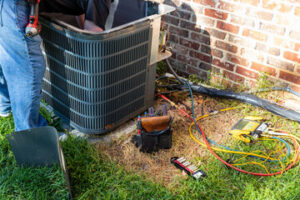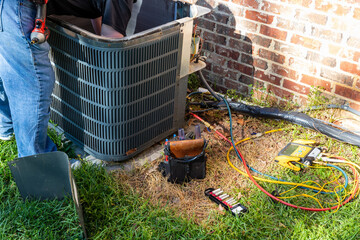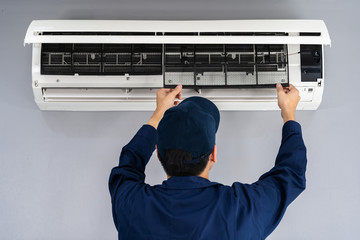HVAC Round Rock system plays a crucial role in maintaining indoor comfort. It regulates temperature, humidity, and air quality. Efficient systems reduce energy consumption and improve overall performance. A well-maintained HVAC unit ensures consistent comfort year-round.
Heating, ventilation, and air conditioning systems are designed to create a balanced indoor environment. Heating components provide warmth during cold seasons. Cooling systems remove excess heat and maintain comfortable temperatures. Ventilation ensures proper airflow and fresh air circulation.
The efficiency of an HVAC system depends on proper installation and maintenance. Professional installation ensures that all components function optimally. Regular maintenance prevents breakdowns and extends the system’s lifespan. A well-maintained system operates at peak performance with minimal energy waste.
Air filters play a key role in maintaining air quality. Filters trap dust, allergens, and pollutants. Clogged filters reduce airflow and strain the system. Regular filter replacement improves air quality and system efficiency.
Ductwork is essential for distributing heated or cooled air. Leaky or poorly insulated ducts lead to energy loss. Proper sealing and insulation enhance airflow and temperature control. Efficient duct systems reduce energy consumption and improve comfort.
Thermostats control the operation of HVAC systems. Programmable thermostats allow users to set schedules and adjust temperatures automatically. Smart thermostats provide remote access and learning capabilities. Accurate temperature control reduces energy costs and enhances comfort.
Heating systems include furnaces, boilers, and heat pumps. Furnaces use combustion to generate heat. Boilers heat water and distribute it through radiators or underfloor systems. Heat pumps transfer heat between indoor and outdoor spaces.
Cooling systems rely on refrigerants and compressors to remove heat. Air conditioners and heat pumps use similar cooling cycles. Proper refrigerant levels and clean coils improve cooling efficiency. Regular maintenance ensures consistent cooling performance.
Ventilation systems maintain fresh air flow and prevent stagnation. Mechanical ventilators exchange indoor and outdoor air. Proper ventilation reduces moisture buildup and prevents mold growth. Balanced airflow enhances indoor air quality and comfort.
HVAC zoning allows different areas to be heated or cooled independently. Dampers and separate thermostats control airflow to specific zones. Zoning improves comfort and reduces energy consumption. Efficient zoning systems adapt to varying occupancy levels.
Humidity control is essential for indoor comfort and health. Dehumidifiers remove excess moisture from the air. Proper humidity levels prevent mold growth and respiratory issues. Balanced humidity improves overall air quality and comfort.
Insulation plays a major role in HVAC efficiency. Properly insulated walls, floors, and ceilings reduce heat loss and gain. Insulated ducts and pipes maintain consistent temperatures. High-quality insulation reduces energy consumption and enhances comfort.
Air balancing ensures even distribution of heated or cooled air. Technicians measure airflow and adjust dampers and vents. Proper balancing prevents hot and cold spots. Even airflow improves comfort and system efficiency.
HVAC systems rely on complex electrical components. Capacitors, relays, and circuit boards regulate system operation. Faulty components cause malfunctions and reduced performance. Regular inspection and replacement prevent system failures.
Refrigerant leaks reduce cooling efficiency and harm the environment. Technicians detect and repair leaks using specialized tools. Proper refrigerant levels ensure efficient heat exchange. Sealing leaks restores optimal cooling performance.
System sizing is critical for HVAC efficiency. Oversized systems short-cycle and waste energy. Undersized systems struggle to maintain comfort. Proper load calculation ensures accurate system sizing and balanced performance.
HVAC maintenance contracts provide regular service and inspections. Technicians clean components, check refrigerant levels, and test system performance. Preventive maintenance reduces repair costs and extends system life. Consistent service improves reliability and efficiency.
Duct cleaning removes dust, debris, and allergens from ventilation systems. Clean ducts improve airflow and indoor air quality. Professional cleaning prevents mold and bacterial growth. Clean ductwork enhances system efficiency and comfort.
Energy-efficient HVAC systems reduce environmental impact. High-efficiency units use advanced compressors and motors. Variable-speed technology adjusts output based on demand. Energy-efficient systems lower utility costs and improve comfort.
Indoor air quality products enhance HVAC performance. Air purifiers remove airborne contaminants. UV lights kill bacteria and mold in the air handler. Enhanced filtration and purification improve overall air quality.
HVAC systems use different types of refrigerants. Newer refrigerants have lower environmental impact. Proper handling and disposal prevent environmental harm. Regular maintenance ensures refrigerant efficiency and compliance with regulations.
Emergency HVAC services address sudden breakdowns and malfunctions. Technicians diagnose issues and perform repairs quickly. Emergency service contracts provide priority response. Fast repairs minimize downtime and restore comfort.
HVAC retrofitting upgrades older systems with modern components. New compressors, coils, and thermostats improve efficiency. Retrofitting extends system life and enhances performance. Modernized systems reduce energy consumption and operating costs.
Heat recovery ventilators improve energy efficiency and air quality. These systems exchange heat between indoor and outdoor air. Heat recovery reduces heating and cooling loads. Improved ventilation enhances comfort and efficiency.
HVAC system noise levels affect comfort and satisfaction. Insulated ducts and vibration-reducing mounts reduce noise. Proper installation minimizes operational noise. Quiet systems improve overall comfort and usability.
Building automation systems integrate HVAC controls with other building functions. Centralized control allows remote monitoring and adjustment. Automated scheduling reduces energy consumption. Integrated systems improve efficiency and responsiveness.
HVAC maintenance training improves technician skills and system performance. Ongoing education ensures knowledge of new technologies. Skilled technicians diagnose and repair issues effectively. Professional training enhances service quality and customer satisfaction.
Smart HVAC technology enhances comfort and efficiency. Learning thermostats adjust based on user habits. Mobile apps provide remote access and control. Smart systems optimize energy use and improve performance.
HVAC system design considers building layout and insulation. Proper duct placement and airflow patterns improve efficiency. Design adjustments reduce pressure loss and temperature variation. Thoughtful design enhances overall system performance.
Airflow testing ensures proper distribution of heated or cooled air. Technicians use specialized equipment to measure airflow. Adjustments improve system balance and comfort. Consistent airflow enhances efficiency and indoor comfort.
HVAC components include fans, compressors, and heat exchangers. Regular inspection and maintenance prevent component failure. Proper lubrication and cleaning improve performance. Well-maintained components extend system life.
Air handler units distribute heated or cooled air throughout a building. Clean coils and filters improve airflow and performance. Proper fan speed settings enhance efficiency. Well-maintained air handlers improve comfort and energy savings.
HVAC system upgrades improve overall efficiency and performance. Newer components provide better control and responsiveness. Upgrades reduce energy costs and improve reliability. Modern systems enhance user comfort and satisfaction.
HVAC monitoring systems track system performance and efficiency. Sensors and controls provide real-time data. Adjustments based on monitoring improve system response. Continuous monitoring enhances comfort and reduces operating costs.
HVAC troubleshooting requires knowledge of electrical and mechanical systems. Technicians use diagnostic tools to identify issues. Prompt diagnosis prevents further damage. Effective troubleshooting restores system function and efficiency.
HVAC duct sealing improves airflow and efficiency. Mastic and tape seal leaks and gaps. Sealed ducts reduce energy loss and improve comfort. Proper sealing enhances overall system performance.
HVAC system warranties provide coverage for repairs and replacements. Extended warranties offer additional protection and peace of mind. Warranty terms depend on installation quality and maintenance. Proper installation ensures warranty coverage and system reliability.
Energy audits identify HVAC inefficiencies and improvement areas. Technicians analyze system performance and energy use. Recommendations improve efficiency and reduce costs. Energy audits enhance overall system performance and savings.
HVAC controls manage temperature, humidity, and ventilation settings. Modern control systems provide precise adjustments. Smart controls enhance user convenience and efficiency. Proper control settings improve comfort and energy savings.


